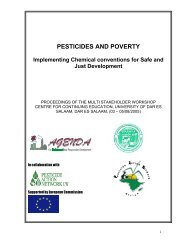Your Daily Poison - Pesticide Action Network UK
Your Daily Poison - Pesticide Action Network UK
Your Daily Poison - Pesticide Action Network UK
You also want an ePaper? Increase the reach of your titles
YUMPU automatically turns print PDFs into web optimized ePapers that Google loves.
3 <strong>Pesticide</strong>s in water<br />
In this section we compare official data from<br />
the government’s Drinking Water Inspectorate<br />
(DWI) with the results we have obtained from<br />
questionnaire survey of both the water<br />
companies who report to the DWI, summarised<br />
in Table 4 (Appendix 6a and 6b), and local<br />
authorities, summarised in Table 6 (Appendix<br />
6c). Local authorities are responsible for<br />
private water supplies, but conduct only a<br />
small number of tests. Indications of ubiquitous<br />
contamination of drinking water at low levels<br />
are confirmed through the PAN <strong>UK</strong> survey. A<br />
gap in the protection of health from potentially<br />
harmful pesticides in water, due to the limited<br />
number of pesticides tested for, is revealed.<br />
According to the official data from the<br />
government’s Drinking Water Inspectorate,<br />
pesticides in water are a minor and diminishing<br />
cause for concern 26 . The legal limit, set by the<br />
European Commission, is 0.1 micrograms per<br />
litre, or one part in ten billion, for a single<br />
pesticide, 0.5 micrograms per litre for the sum<br />
of detectable concentrations of individual<br />
pesticides, and 0.03 micrograms per litre for<br />
the pesticides aldrin, dieldrin, heptachlor and<br />
heptachlor epoxide 27 (persistent organochlorine<br />
pesticides now banned in the <strong>UK</strong> and globally<br />
under the Stockholm Convention, but still<br />
detected many years after their use). Only 18<br />
‘exceedances’ of the legal limit for pesticides<br />
were detected in 2004. This is a decrease from<br />
31 in 2003 and 72 in 2002. However, data<br />
gathered in the PAN <strong>UK</strong> survey (see Table 4)<br />
indicates that drinking water contains low<br />
levels of pesticides. Looking in detail at both<br />
the public and private water supply, the<br />
presence of pesticides is confirmed in both raw<br />
Table 4. <strong>Pesticide</strong>s in the public water supply.<br />
Summary of PAN <strong>UK</strong> survey – Appendix 6a, page 39<br />
PAN <strong>UK</strong> Questionnaires sent to: All 26 water companies in England and<br />
Wales, Scottish Water, and the<br />
Northern Ireland Drinking Inspectorate<br />
Number of responses received: In 2004 (2002 data) In 2005 (2004<br />
data)<br />
12 12<br />
Number of companies reporting<br />
10 or more pesticides found<br />
above 0.01 micrograms per litre<br />
(below the legal limit) in raw<br />
(untreated) water<br />
4 5<br />
Number of companies reporting<br />
10 or more pesticides found<br />
above 0.01 micrograms per<br />
litre (below the legal limit)<br />
in drinking (treated) water<br />
4 5<br />
12<br />
(untreated), and drinking water at levels which<br />
are below the legal limit, but above the limit of<br />
detection. As the EC legal limit was intended to<br />
achieve zero pesticides in drinking water on a<br />
precautionary basis 28 , our evidence indicates<br />
that, to maintain this objective, the legal limit<br />
needs to be lowered to the levels at which<br />
pesticides can now be detected. Harmful<br />
effects are suspected to risk, in particular, the<br />
foetus. The health effects of a lifetime’s<br />
exposure to a mixture of chemicals at low<br />
levels is unknown.<br />
Of the twelve water companies who received<br />
and responded to our survey, seven companies<br />
completed the section in our questionnaire<br />
which asked them to report the levels of<br />
pesticides found below the legal limit, but<br />
above the limit of detection. In Appendix 6b we<br />
present the highest occurrences: atrazine,<br />
isoproturon, mecoprop, propyzamide and<br />
simazine are all being detected in a high<br />
number of tests. According to Southern Water,<br />
atrazine occurred in 62.6 per cent of drinking<br />
water samples, and simazine in 43.2 per cent<br />
of drinking water samples. Numerous other<br />
pesticides are routinely detected in a lower<br />
percentage of tests. The water companies<br />
varied in their facility to extract data in the<br />
format of our information request.<br />
According to the Drinking Water Inspectorate,<br />
aldin, dieldrin, heptachlor and heptachlor<br />
epoxide are ‘generally are not found in water<br />
sources 29 ’. These are obsolete pesticides,<br />
banned since the 1980s on health grounds,<br />
which have not had approved uses in the <strong>UK</strong><br />
for many years. However, the PAN <strong>UK</strong> survey<br />
showed that these pesticides are present in<br />
water.<br />
Of the respondents to PAN <strong>UK</strong>’s survey who<br />
disclosed details about pesticides tested for,<br />
and detected at levels below the legal limit, but<br />
above the limit of detection, the following water<br />
companies reported in their questionnaire<br />
return the presence of these pesticides in raw<br />
or treated water: Bristol, Dee Valley, Essex &<br />
Suffolk, Mid Kent, Northumbrian, Southern,<br />
South Staffordshire, Sutton & East Surrey,<br />
Wessex. Aldrin, dieldrin and heptachlor are<br />
classified carcinogens and endocrine<br />
disruptors according to international<br />
authorities 30 . Some studies have found banned<br />
pesticides, including these, occurring in<br />
rainwater 31 indicating that they persist in the<br />
<strong>Your</strong> daily poison

















